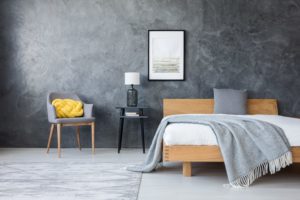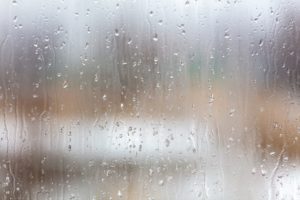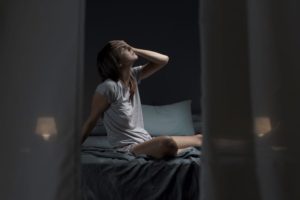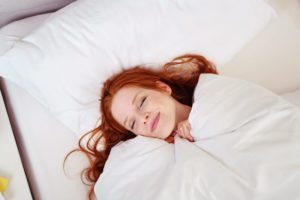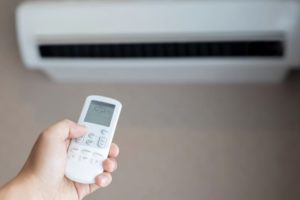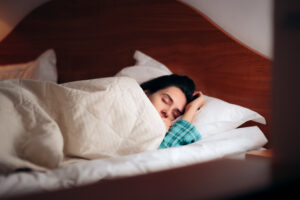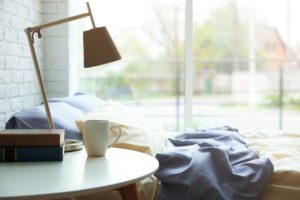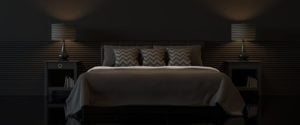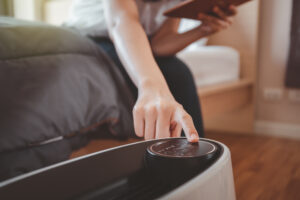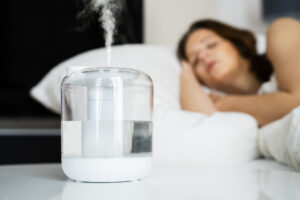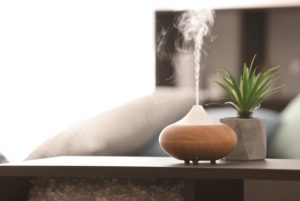Mold in the Bedroom
While kitchens and bathrooms are known for harboring mold, it often surprises people to learn that mold can invade their bedroom, too. And if you’re getting at least seven hours of sleep , a moldy bedroom becomes a significant source of mold exposure.
Mold can cause numerous health problems, and evidence suggests it can disrupt your sleep. As a result, it’s important to learn about the causes of mold growth, the signs of mold, and the steps you can take to control mold in the bedroom.
What Is Mold?
Molds are naturally occurring fungi found indoors and outdoors. There are thousands of mold strains, which all require moisture for growth.
Mold spreads to new environments by releasing microscopic spores that travel through the air. Trace amounts of mold are always circulating in the air and environment , but spores begin to grow when they land somewhere with a suitable amount of moisture.
Mold and Your Health
Molds release several substances that can cause allergic reactions, irritations, and toxic effects when touched or inhaled. While most strains of mold are harmless, there are more than 100 different kinds of indoor molds that may be harmful to humans . Fortunately, only a small number of these molds are usually found in homes.
Health effects from mold can vary, but common reactions may include:
- Skin redness or rash
- Itchy, red eyes
- Sneezing
- Nasal congestion
- Chronic cough
- Blurred vision
More severe symptoms such as fever, shortness of breath, and lung infection may occur from mold exposure in people with underlying health conditions or a weakened immune system. Children exposed to mold in the first year of life may have an increased risk of developing asthma.
Mold and Your Sleep
In addition to the many health problems mold can cause, research suggests that mold exposure may also compromise sleep. In one large study, household molds were correlated with increased sleep problems like insomnia, snoring, and excessive daytime sleepiness. Another study of nearly 5,000 adults found that people who reported mold odors at home also reported higher rates of sleep disturbances .
In addition, indoor molds are a known cause of allergic rhinitis . Emerging research shows the potential for allergic rhinitis to cause a host of sleep problems including insomnia, restless sleep, obstructive sleep apnea, and snoring.
The Moldy Bedroom
Though your bedroom may appear clean and tidy, a host of factors can turn your sleep sanctuary into a habitat for mold. Mold is capable of growing on a variety of materials , particularly porous and natural materials such as cardboard, paper, wood products, and ceiling tiles. Mold can also grow inside other surfaces around your bedroom including the wallpaper and insulation.
Water Sources, Humidity, and Condensation
Molds need sufficient moisture to grow and spread. The bedroom can harbor hidden moisture from leaks in the roof, windows, pipes, or areas of flooding. These moisture sources are all commonly associated with mold growth. Mold can also form if water is spilled and not dried within 48 hours.
However, it does not take an overt spill or leak for mold to form. Mold can arise if your bedroom is excessively humid or accumulates condensation, which can result from poor ventilation. Even modest amounts of condensation can support mold growth. Areas of your bedroom with minimal air movement , such as behind furniture and inside closets, may have higher levels of condensation and dampness.
Signs of a Moldy Bedroom
If you’re inspecting your bedroom for mold, it’s important to know that mold can grow for some time before it becomes visible. Therefore, when assessing your bedroom, keep an eye out for these signs of mold growth :
- A humid or damp closet
- Condensation on windows
- Cracking paint, a dark area on a wall, or other signs of water damage
- An unusual, musty odor
You may also see mold develop in areas with regular moisture or condensation. For example, black mold spots may become visible in corners of your bedroom or behind furniture that is kept up against the wall.
Sometimes mold may be concealed underneath wallpaper, paneling, carpet, or behind walls. If you suspect that hidden mold is growing in your bedroom, it’s smart to consider hiring a professional who can perform a thorough investigation of your home.

Controlling Mold in the Bedroom
Keep in mind that it’s nearly impossible to keep mold spores from entering your home. Microscopic spores can come in through open airways, windows, and vents, or latch onto clothing and pets. Therefore, the best approach to preventing mold is to make sure your bedroom environment doesn’t support its growth.
Preventing Mold Growth
To prevent mold in your bedroom, it’s important to control humidity, increase ventilation, and immediately clean up any standing water or spills. To accomplish this, make sure to:
- Keep humidity low and consider using a digital monitor to keep humidity between 30% and 50%
- Ensure proper ventilation and airflow
- Quickly treat any structural water leaks from the roof, pipes, or other sources
- Use a dehumidifier or A/C if your bedroom is prone to moisture
- Move furniture away from the wall
- Create space between clothes and other items in your closet
- Do not leave stacks of clothing, bedding, or papers undisturbed for long periods
- If water spills on your carpet or mattress, clean and dry it within 48 hours
- Enlist professional help for large water spills or flooding
Getting Rid of Mold
Should you discover mold growth, prompt and thorough cleaning is critical. Consider the following guidelines for effective cleaning:
- Nonporous materials and hard surfaces can be cleaned with chemical products, soap and water, or a bleach solution
- Wear gloves, goggles, and a respirator when cleaning mold in order to protect against airborne particles
- Porous materials with mold should be discarded, not cleaned
- Remove and replace moldy insulation, ceiling tiles, and drywall
- Mold growth over 10 square feet may require professional cleaning
The Environmental Protection Agency and many local health departments offer additional guidance for cleaning household mold.
Is It Important To Test Mold?
Mold growing in your bedroom — no matter the type — should be removed. The health risk is not necessarily tied to a certain type or amount of mold. Therefore, there are no federal limits on acceptable levels of indoor mold, and expert groups typically do not recommend routine testing for mold strains.
The important thing is to rid your home of any known mold immediately, or better yet, prevent mold from growing in the first place. You’ll rest better knowing that you’re doing everything you can to keep this silent invader out of your bedroom.

Still have questions? Ask our community!
Join our Sleep Care Community — a trusted hub of sleep health professionals, product specialists, and people just like you. Whether you need expert sleep advice for your insomnia or you’re searching for the perfect mattress, we’ve got you covered. Get personalized guidance from the experts who know sleep best.
References
15 Sources
-
Consensus Conference Panel, Watson, N. F., Badr, M. S., Belenky, G., Bliwise, D. L., Buxton, O. M., Buysse, D., Dinges, D. F., Gangwisch, J., Grandner, M. A., Kushida, C., Malhotra, R. K., Martin, J. L., Patel, S. R., Quan, S. F., Tasali, E., Non-Participating Observers, Twery, M., Croft, J. B., Maher, E., … Heald, J. L. (2015). Recommended amount of sleep for a healthy adult: A joint consensus statement of the American Academy of Sleep Medicine and Sleep Research Society. Journal of Clinical Sleep Medicine, 11(6), 591–592.
https://pubmed.ncbi.nlm.nih.gov/25979105/ -
Centers for Disease Control and Prevention. (2020, August 11). Basic Facts about Mold and Dampness., Retrieved December 13, 2021, from
https://www.cdc.gov/mold/faqs.htm -
Wood, R. A., Eggleston, P. A., Lind, P., Ingemann, L., Schwartz, B., Graveson, S., Terry, D., Wheeler, B., & Adkinson, N. F., Jr (1988). Antigenic analysis of household dust samples. The American Review of Respiratory Disease, 137(2), 358–363.
http://www.atsjournals.org/doi/abs/10.1164/ajrccm/137.2.358 -
Seguel, J. M., Merrill, R., Seguel, D., & Campagna, A. C. (2016). Indoor Air Quality. American journal of lifestyle medicine, 11(4), 284–295.
https://pubmed.ncbi.nlm.nih.gov/30202344/ -
Environmental Protection Agency. (2021, August 14). A Brief Guide to Mold, Moisture and Your Home., Retrieved December 13, 2021, from
https://www.epa.gov/mold/brief-guide-mold-moisture-and-your-home -
National Institute of Environmental Health Sciences. (2021, November 4). Mold., Retrieved December 13, 2021 from
https://www.niehs.nih.gov/health/topics/agents/mold/index.cfm -
Wang, J., Janson, C., Lindberg, E., Holm, M., Gislason, T., Benediktsdóttir, B., Johannessen, A., Schlünssen, V., Jogi, R., Franklin, K. A., & Norbäck, D. (2020). Dampness and mold at home and at work and onset of insomnia symptoms, snoring and excessive daytime sleepiness. Environment international, 139, 105691.
https://linkinghub.elsevier.com/retrieve/pii/S0160412020301008 -
Shiue I. (2015). Indoor mildew odour in old housing was associated with adult allergic symptoms, asthma, chronic bronchitis, vision, sleep and self-rated health: USA NHANES, 2005-2006. Environmental Science and Pollution Research International, 22(18), 14234–14240.
http://link.springer.com/10.1007/s11356-015-4671-8 -
A.D.A.M. Medical Encyclopedia. (2020, February 2). Allergic rhinitis., Retrieved December 13, 2021, from
https://medlineplus.gov/ency/article/000813.htm -
Léger, D., Annesi-Maesano, I., Carat, F., Rugina, M., Chanal, I., Pribil, C., El Hasnaoui, A., & Bousquet, J. (2006). Allergic rhinitis and its consequences on quality of sleep: An unexplored area. Archives of internal medicine, 166(16), 1744–1748.
http://archinte.jamanetwork.com/article.aspx?doi=10.1001/archinte.166.16.1744 -
Liu, J., Zhang, X., Zhao, Y., & Wang, Y. (2020). The association between allergic rhinitis and sleep: A systematic review and meta-analysis of observational studies. PloS one, 15(2), e0228533.
https://pubmed.ncbi.nlm.nih.gov/32053609/ -
Centers for Disease Control and Prevention. (2020, July 17). You Can Control Mold., Retrieved December 13, 2021, from
https://www.cdc.gov/mold/control_mold.htm -
Storey, E., Dangman, K., Schenck, P., DeBernardo, R., & Yang, C. (2004). Guidance for clinicians on the recognition and management of health effects related to mold exposure and moisture indoors. Center for indoor environments and health., Retrieved December 13, 2021, from
https://health.uconn.edu/occupational-environmental/wp-content/uploads/sites/25/2015/12/mold_guide.pdf -
Environmental Protection Agency. (2001, July 13). Mold coure chapter 2: why and where mold grows., Retrieved December 13, 2021, from
https://www.epa.gov/mold/mold-course-chapter-2 -
Environmental Protection Agency. (2021, November 4). Text Version of the Mold House Tour., Retrieved December 13, 2021, from
https://www.epa.gov/mold/text-version-mold-house-tour




